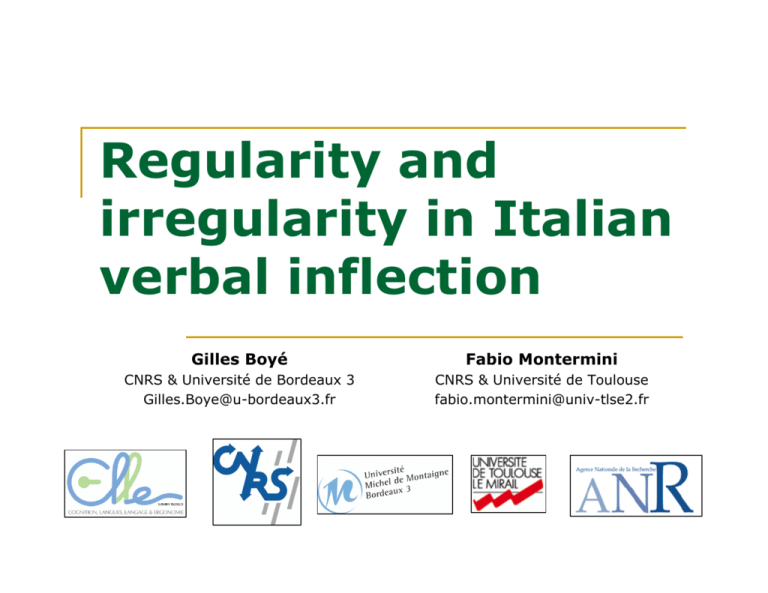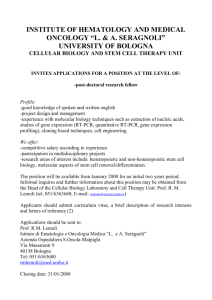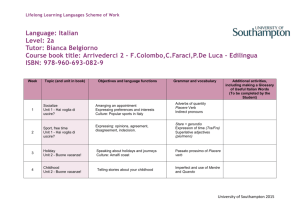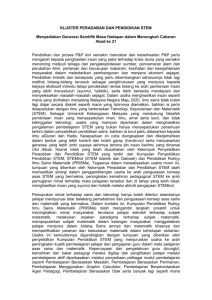Regularity and irregularity in Italian verbal inflection
advertisement

Regularity and irregularity in Italian verbal inflection Gilles Boyé Fabio Montermini CNRS & Université de Bordeaux 3 Gilles.Boye@u-bordeaux3.fr CNRS & Université de Toulouse fabio.montermini@univ-tlse2.fr Theoretical framework An analysis of Italian verb conjugation in a ‘Word and Paradigm’ model What’s new: A more detailed analysis of the relationship between forms Multiple parameters are taken into account (segmental, prosodic…) Possible linking with psycholinguistic experimentation Possible implementation and modelization (cf. Pirrelli & Battista [2000] for Italian, Bonami & Boyé [2003] for French , Boyé & Cabredo Hofherr [2006] for Spanish) Some questions How do speakers use (and learn) the inflectional system of their language? How a speaker has immediate access to the whole paradigm of a word by learning a single form? Are there any limitations to the complexity in the structure of a lexeme (word)? The notion of stem space Irregularity in the paradigm of English verbs A A +ed A⊕ed A A A B B B +ed A⊕ed = = A⊕ed B B C A LOVE MOW LEAVE SING * The notion of stem space Italian present indicative Infinitive (S1) 3rd person (S3) 1st person (S2) ‘fear’ A tem⊕ere A tem⊕e A tem⊕o ‘be worthy’ A val⊕ere A val⊕e B valg⊕o ‘must’ A dov⊕ere B dev⊕e B dev⊕o ‘keep’ A ten⊕ere B tjen⊕e C teng⊕o * A B A The notion of stem space Irregularity is distributed in a systematic way. Irregulars are not a more complex case of regulars; rather, the latter are a simplification of the former. A lexeme is planned to reach a certain degree of complexity. No lexeme displays the maximal complexity; the majority of lexemes (i.e. the regulars) display the minimal complexity. The stem space of Italian verbs 1 2 3 4 5 6 Fut. Ind. S6⊕ró S6⊕ráj S6⊕rá S6⊕rémo S6⊕réte S6⊕ránno Pres. Cnd. S6⊕réj S6⊕résti S6⊕rébbe S6⊕rémmo S6⊕réste S6⊕rébbero Pres. Sbj. S2 S2 S2 S4⊕iámo S4⊕iáte S2⊕no Pres Ind. S2|V ⇒ o S2|V ⇒ i S3 S4⊕iámo S1⊕te S2 i ⇒ a/a ⇒ o ⊕no Impf. Ind. S1⊕vo S1⊕vi S1⊕va S1⊕vámo S1⊕váte S1⊕vano Impf. Sbj. S1⊕ssi S1⊕ssi S1⊕ssi S1⊕ssimo S1⊕ste S1⊕ssero Past Ind. S5⊕i S1⊕sti S5|á ⇒ ó S1⊕mmo S1⊕ste S5⊕ro(no) Imperative S5|e ⇒ i Pres. part. S1|i ⇒ e | ⊕nte Gerund S1|i ⇒ e | ⊕ndo Past part. S7|e ⇒ u | ⊕to Infinitive S8⊕re How to fill the stem space? S2 TV = last vowel of the stem if /a/ ⇒ /i/ iʃe ⇒ iska /kánta/ => /kánti/ (‘sing’) if TV = /e/, stress on Theme Vowel ⇒ on Pre-Thematic vowel /kredévo/ ⇒ /krédere/ (‘believe’) a⇒i|e⇒a stress on Theme Vowel ⇒ on Pre-Thematic vowel S3 /kantávo/ ⇒ /kánta/ (‘sing’) i ⇒ iʃe stress TV ⇒ PTV S1 é : stress TV ⇒ PTV = TV ⇒ ∅ a⇒e suppress stress S6 S8 S7 S4 é ⇒ étte S5 From stems to forms S1 kantá ⊕vo S3 kánta V ⇒i ⊕te kantávo kantáte 1SG IMPF IND 1PL PRES IND … = S2 kánti e⇒i = V ⇒o kánti kánta kánta kánti kánto 2SG PRES IND 3SG PRES IND 2SG IMPER 123SG PRES SUBJ 1SG PRES IND … Conjugation What’s in the grammar: •The stem indexing: for every form the index of its stem •The stem graph: the default rules for circulating between stems S2 = S3 iʃe ⇒ iska | a ⇒ i | e ⇒ a S3 = S1 i ⇒ iʃe | stress TV ⇒ PTV S4 = S1 | TV ⇒ ∅ S5 = S7 | é ⇒ étte S6 = S8 | a ⇒ e | suppress stress S7 = S1 S8 = S1 | é stress TV ⇒ PTV •The form recipes: the rules for constructing each form. Conjugation What’s in the lexicon: •For regulars: just one stem (typically S2 or S3, since they are the only ones which bear information about idiosyncratic stress, cf. /kómpliko/ ‘I complicate’ vs /fatíko/ ‘I work hard’) •All irregular stems (e.g. USCIRE ‘go out’, S1=uʃí / S2=éska / S3=éʃe) •All irregular inflected forms (e.g. sono ‘I am’) The rules The rules may specify a segmental operation (the adjunction of a suffix), another kind (e.g. prosodic) of operation, or no operation at all Most rules are phonologically natural, but not phonologically motivated; therefore, phonologically unnatural rules are not excluded (e.g. /i/ ⇒ /iʃe/ in /finívo/ ⇒ /finíʃe/) Stem realization rules and inflected forms realization rules have the same format. There is no qualitative distinction. We may find suppletion at both levels (suppletive stems, e.g. /tenére/ ‘keep’ vs /téngo/ ‘I keep’ or suppletive forms, see sono above) The classes The rules refer to TVs (Theme Vowels) and not to classes, because there is a great redundancy in the paradigm of verbs which have different TVs. Unlike, for instance, the 5 classes of Latin nouns: I II III IV V Nom Xa Xus X Xus Xes Gen Xae Xi Xis Xus Xei Dat Xae Xo Xi Xui Xei Acc Xam Xum Xem Xum Xem Voc Xa Xe X Xus Xes Abl Xa Xo Xe Xu Xe Regularity vs irregularity A regular lexeme (verb) is a lexeme for which a speaker is able to reconstruct the whole paradigm from any inflected form "Class 1" "Class 2" "Class 3" LAVARE CREDERE FINIRE ‘wash’ ‘believe’ ‘end’ S1/lavávo/ S1/kredévo/ S1/finívo/ S3/láva/ S8/krédere/ S3/finíʃi/ S2/lávi/ S2/finíska/ Regularity vs irregularity Identity between stems throughout the paradigm (the traditional notion of regularity) is a common case, but not the only case. See: verbs like FINIRE ‘end’: S1/finívo/ - S3/finíʃi/ - S2/finíska/ regular vs verbs like DORMIRE ‘sleep’ (~15 entries) S1/dormívo/ - S3/dórmi/ - S2/dórma/ irregular verbs like CREDERE ‘believe’: S1/kredévo/ - S8/krédere/ vs TEMERE ‘fear’ (1 entry!) S1/temévo/ - S8/temére/ regular irregular References Bonami, O., Boyé G. (2003), Supplétion et classes flexionnelles dans la conjugaison du français, Langages, 152: 102-126. Boyé, G., Cabredo Hofherr P. (2006), The structure of allomorphy in Spanish verbal inflection, Cuadernos de Lingüística del Instituto Universitario Ortega y Gasset, 13.3: 9-24. Burzio L. (2004), Paradigmatic and syntagmatic relations in Italian verbal inflection, in: Auger J., Clancy Clements J., Vance B. (eds), Contemporary Approaches to Romance Linguistics, Amsterdam, John Benjamins: 17-44. Maiden M. (2003), Il verbo italoromanzo: verso una storia autenticamente morfologica, in: Giacomo-Marcellesi M., Rocchetti A. (eds), Il verbo italiano. Studi diacronici, sincronici, contrastivi, didattici, Roma, Bulzoni: 3-21. Matthews P. (1981), Present stem alternations in Italian, in: Geckeler E. et al. (eds), Logos Semantikos. Studia linguistica in honorem Eugenio Coseriu, vol. IV, Madrid, Gredos / New York / Berlin, Mouton de Gruyter: 57-65. Napoli D.J., Vogel I. (1990), The conjugations of Italian, Italica, 67.4: 479-502. Pirrelli V., Battista M. (2000), The paradigmatic dimension of stem allomorphy in Italian verb inflection, Rivista di Linguistica, 12.2: 307-330. Thornton A.M. (1999), Diagrammaticità, uniformità di codifica e morfomicità nella flessione verbale italiana, in: Benincà P., Mioni A.M., Vanelli L. (eds), Fonologia e morfologia dell’italiano e dei dialetti d’Italia, Roma, Bulzoni: 483-502. (2006), Is there a partition in the present indicative of Italian regular verbs?, paper presented at the 12th International Morphology Meeting, Budapest, May 25-28.



